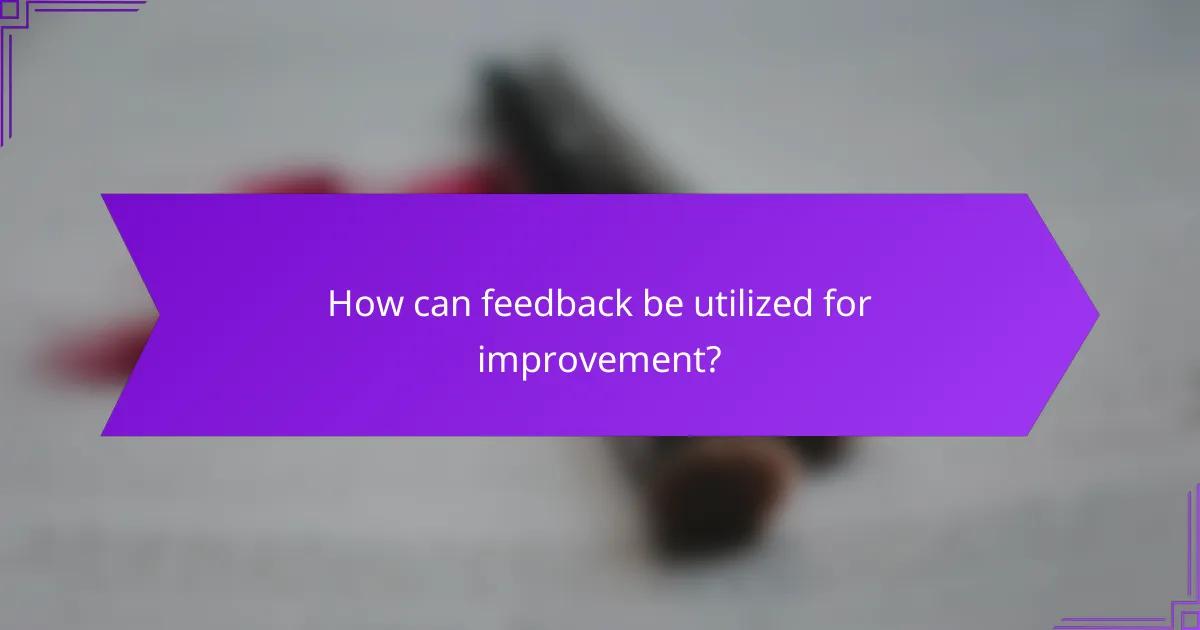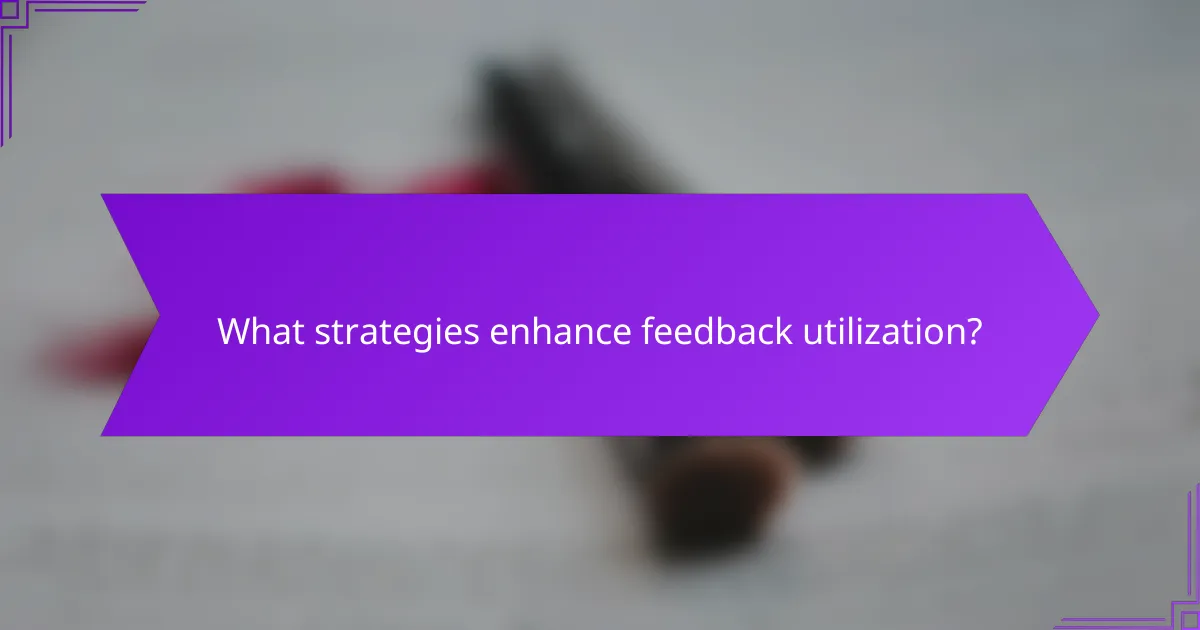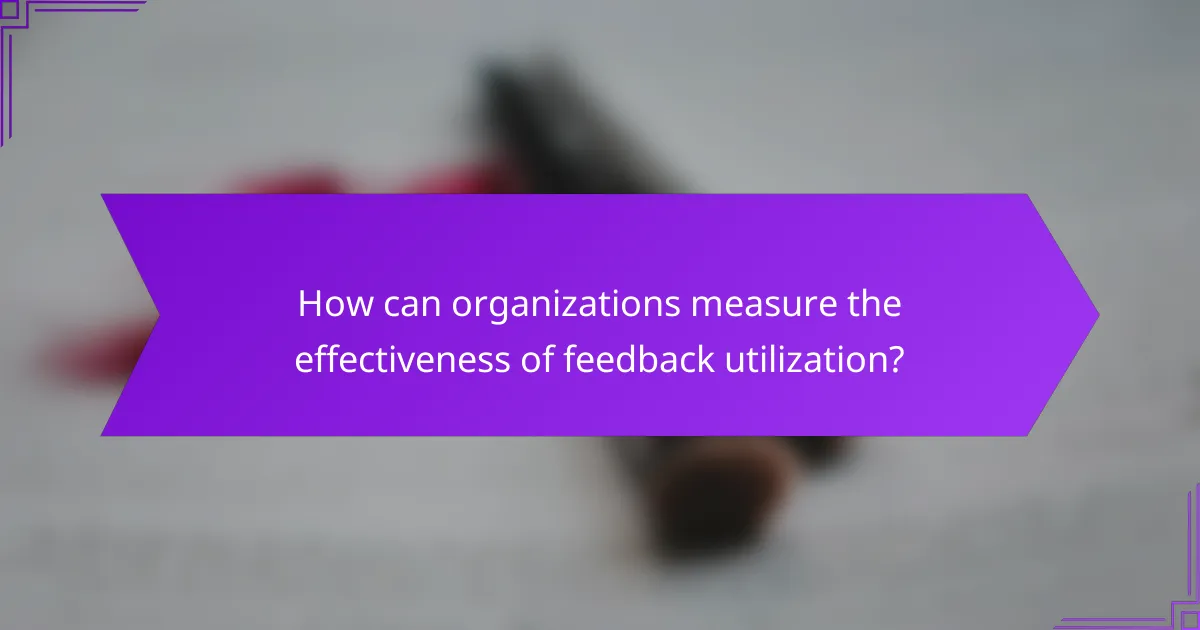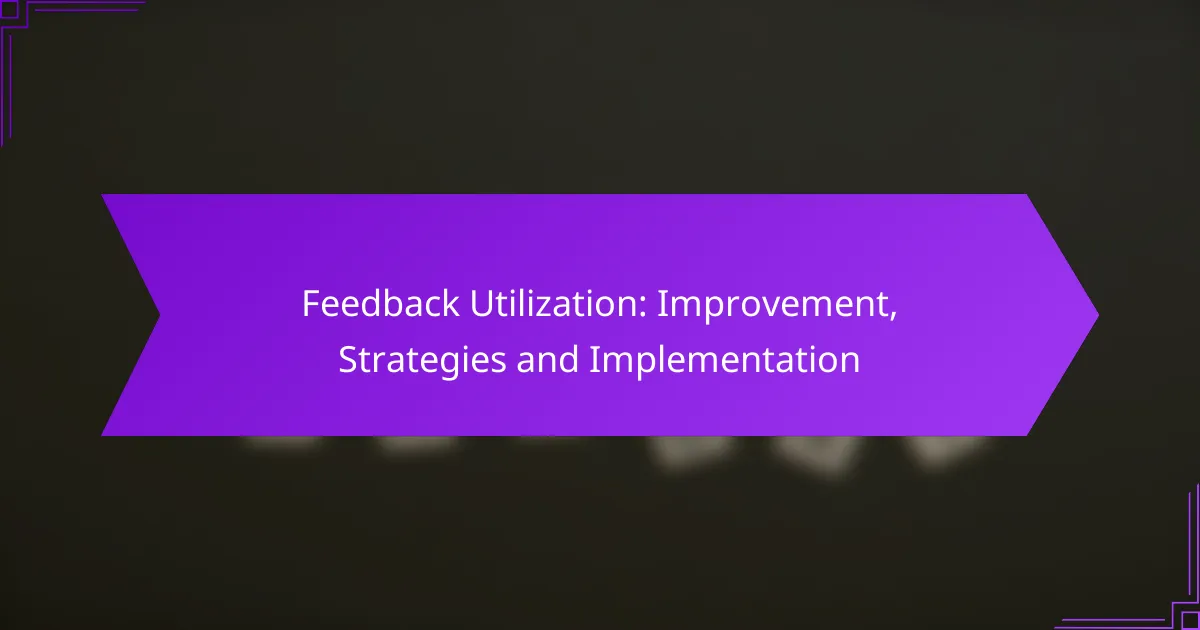Utilizing feedback effectively is crucial for driving improvement and fostering a culture of continuous growth. By systematically gathering and analyzing insights, organizations can implement meaningful changes that enhance performance. Strategies for effective feedback utilization focus on creating an environment that values open communication and integrates feedback into everyday processes.

How can feedback be utilized for improvement?
Feedback can be effectively utilized for improvement by systematically gathering insights, analyzing them, and implementing changes based on the findings. This process not only enhances performance but also fosters a culture of continuous growth and adaptation.
Identifying areas for enhancement
To identify areas for enhancement, organizations should collect feedback from various sources, including customers, employees, and stakeholders. Surveys, interviews, and performance reviews are effective methods for gathering this information.
Once feedback is collected, categorize it into themes such as service quality, product features, or employee engagement. This helps pinpoint specific areas that require attention and improvement.
Implementing changes based on feedback
Implementing changes involves prioritizing the identified areas based on their potential impact and feasibility. Start with small, manageable adjustments that can be quickly executed to demonstrate responsiveness to feedback.
Engage teams in brainstorming sessions to generate ideas for solutions. Ensure that changes are communicated clearly to all stakeholders, and provide training if necessary to facilitate the transition.
Measuring impact of improvements
Measuring the impact of improvements is crucial to determine the effectiveness of the changes made. Establish key performance indicators (KPIs) that align with the areas addressed, such as customer satisfaction scores or employee productivity metrics.
Regularly review these metrics over time to assess whether the improvements have led to desired outcomes. Adjust strategies as needed based on ongoing feedback and performance data to ensure continuous improvement.

What strategies enhance feedback utilization?
Effective feedback utilization strategies focus on fostering an environment where feedback is valued and systematically integrated into processes. This involves creating a culture that encourages open communication, leveraging technology for efficient feedback collection, and training staff to accurately interpret and act on feedback.
Creating a feedback culture
Establishing a feedback culture requires leadership commitment and clear communication about the importance of feedback. Encourage regular discussions where team members feel safe to share their thoughts without fear of repercussions.
Implementing structured feedback sessions, such as weekly check-ins or monthly reviews, can help normalize the practice. Recognize and reward individuals who actively participate in giving and receiving feedback to reinforce its value.
Utilizing technology for feedback collection
Technology can streamline the feedback collection process, making it easier to gather insights from various stakeholders. Tools like online surveys, feedback apps, and collaboration platforms can facilitate real-time feedback and ensure anonymity when needed.
Consider using platforms that allow for quick responses, such as pulse surveys, which can be conducted frequently to gauge sentiments. Ensure that the technology chosen is user-friendly to encourage participation across all levels of the organization.
Training staff on feedback interpretation
Training staff on how to interpret feedback effectively is crucial for maximizing its impact. Workshops and training sessions can help employees understand the nuances of feedback, including how to differentiate between constructive criticism and personal opinions.
Provide practical examples and role-playing scenarios to enhance learning. Encourage staff to ask clarifying questions when receiving feedback to ensure they fully understand the context and intent behind it.

What are the best practices for implementing feedback strategies?
Implementing effective feedback strategies involves creating structured methods for gathering, analyzing, and acting on feedback. Best practices ensure that feedback is not only collected but also utilized to drive improvements and foster a culture of continuous enhancement.
Establishing clear feedback channels
Clear feedback channels are essential for encouraging open communication. This can include designated platforms such as surveys, suggestion boxes, or regular meetings where team members can express their thoughts. Ensure that these channels are easily accessible and well-publicized within the organization.
Consider using a mix of anonymous and identifiable feedback options to cater to different comfort levels. For instance, anonymous surveys can yield honest insights, while identifiable channels can foster accountability and follow-up discussions.
Regularly reviewing feedback processes
Regular reviews of feedback processes help maintain their effectiveness and relevance. Schedule periodic assessments to evaluate how feedback is collected, analyzed, and acted upon. This can involve gathering input from employees about the feedback mechanisms themselves to identify areas for improvement.
Establish a routine, such as quarterly reviews, to ensure that feedback strategies evolve with changing organizational needs. This practice not only enhances the quality of feedback but also demonstrates a commitment to valuing employee input.

How does feedback utilization vary across industries?
Feedback utilization differs significantly across industries, shaped by specific operational needs and customer interactions. While some sectors prioritize immediate responses to enhance service quality, others focus on long-term improvements based on aggregated feedback data.
Feedback in healthcare settings
In healthcare, feedback is crucial for improving patient care and operational efficiency. Hospitals often utilize patient surveys and follow-up calls to gather insights on service quality, which can lead to adjustments in treatment protocols and staff training.
For effective feedback utilization in healthcare, organizations should ensure anonymity to encourage honest responses. Additionally, integrating feedback into regular staff meetings can foster a culture of continuous improvement, ultimately enhancing patient outcomes.
Feedback in retail environments
Retail environments leverage feedback to optimize customer experience and product offerings. Common methods include in-store surveys, online reviews, and loyalty program feedback, which help retailers understand consumer preferences and shopping behaviors.
To maximize feedback effectiveness in retail, businesses should analyze trends from customer input and act on them promptly. Implementing changes based on feedback, such as adjusting product displays or enhancing customer service training, can significantly boost customer satisfaction and retention rates.

What are the common challenges in feedback utilization?
Common challenges in feedback utilization include resistance to change and a lack of actionable insights. These obstacles can hinder organizations from effectively implementing feedback, ultimately affecting performance and growth.
Resistance to change
Resistance to change is a significant barrier when trying to utilize feedback effectively. Employees may feel comfortable with existing processes and fear that changes could disrupt their workflow or lead to uncertainty about their roles.
To address this, leadership should foster a culture that values feedback and emphasizes its importance for improvement. Engaging employees in discussions about the benefits of changes can help reduce resistance and encourage a more open mindset.
Lack of actionable insights
A lack of actionable insights from feedback can prevent organizations from making meaningful improvements. Feedback that is vague or not clearly linked to specific actions can leave teams unsure of how to proceed.
To overcome this challenge, organizations should focus on gathering specific, measurable feedback that can be directly tied to goals. Using structured feedback forms or surveys with clear questions can help ensure that the insights gained are practical and applicable.

How can organizations measure the effectiveness of feedback utilization?
Organizations can measure the effectiveness of feedback utilization by tracking specific metrics that indicate how well feedback is integrated into processes and decision-making. This involves assessing both qualitative and quantitative data to understand the impact of feedback on performance and employee engagement.
Key performance indicators (KPIs)
Key performance indicators (KPIs) are essential for evaluating the effectiveness of feedback utilization. Common KPIs include employee turnover rates, productivity levels, and the speed of project completion. By monitoring these indicators, organizations can gauge how feedback influences overall performance.
For example, a decrease in employee turnover after implementing feedback mechanisms may suggest that employees feel more valued and engaged. Organizations should establish baseline metrics before implementing feedback strategies to measure changes accurately.
Employee satisfaction surveys
Employee satisfaction surveys are a direct method for assessing how feedback is utilized within an organization. These surveys can include questions about how employees perceive feedback processes, whether they feel heard, and how feedback affects their work environment. Regularly conducting these surveys helps track changes over time.
To ensure effectiveness, surveys should be anonymous and cover various aspects of feedback, such as clarity, frequency, and impact. Analyzing survey results can reveal trends and areas needing improvement, enabling organizations to adjust their feedback strategies accordingly.



